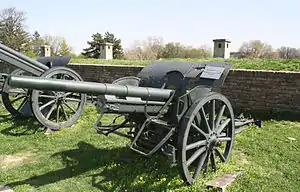| Canon de 75 Mle GP III | |
|---|---|
 In Belgrade military museum | |
| Type | field gun |
| Place of origin | Belgium |
| Service history | |
| In service | 1919?-1945 |
| Used by | |
| Wars | World War II |
| Production history | |
| Designer | Cockerill |
| Manufacturer | Cockerill |
| Specifications | |
| Mass | 2,337 kg (5,152 lb) (travel) 1,390 kg (3,060 lb) (combat)[1] |
| Barrel length | 2.8 metres (9 ft 2 in) L/37.3[1] |
| Shell | Fixed QF 75 x 150mm R |
| Shell weight | 6.125 kilograms (13.50 lb)[2] |
| Caliber | 75 mm (2.95 in) |
| Carriage | Box trail |
| Elevation | -8° to +35° |
| Traverse | 8° |
| Muzzle velocity | 579 m/s (1,899 ft/s) |
| Maximum firing range | 11 kilometres (6.8 mi) |
The Canon de 75 mle GPIII was a field gun used by Belgium during World War II. Cockerill mounted a sleeve in the barrels of ex-German 7.7 cm FK 16 guns received as reparations after World War I to convert them to the standard Belgian 75mm ammunition. After 1940, the Wehrmacht designated captured guns as the 7.5 cm FK 236(b). This gun was nearly the equivalent of the German 7.5 cm FK 16 nA and apparently saw wider service than the other captured Belgian guns.
Notes
- 1 2 Chamberlain, Peter (1975). Light and medium field artillery. Gander, Terry. New York: Arco. p. 3. ISBN 0668038209. OCLC 2067331.
- ↑ "75-77 MM CALIBRE CARTRIDGES". quarryhs.co.uk. Archived from the original on 11 October 2017. Retrieved 2 September 2017.
References
- Chamberlain, Peter & Gander, Terry. Light and Medium Field Artillery. New York: Arco, 1975
- Gander, Terry and Chamberlain, Peter. Weapons of the Third Reich: An Encyclopedic Survey of All Small Arms, Artillery and Special Weapons of the German Land Forces 1939-1945. New York: Doubleday, 1979 ISBN 0-385-15090-3
This article is issued from Wikipedia. The text is licensed under Creative Commons - Attribution - Sharealike. Additional terms may apply for the media files.